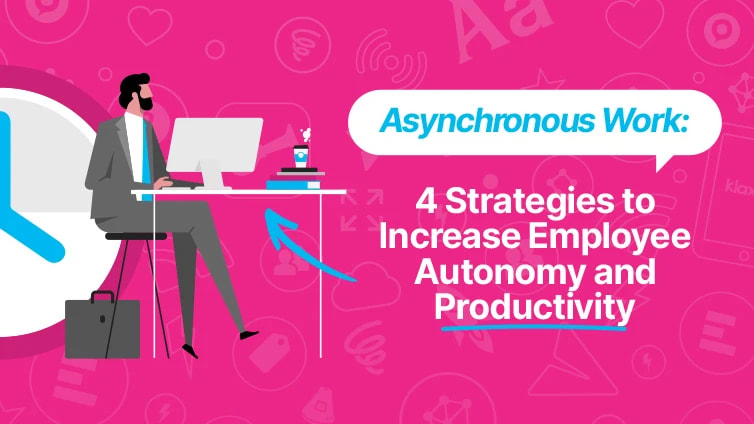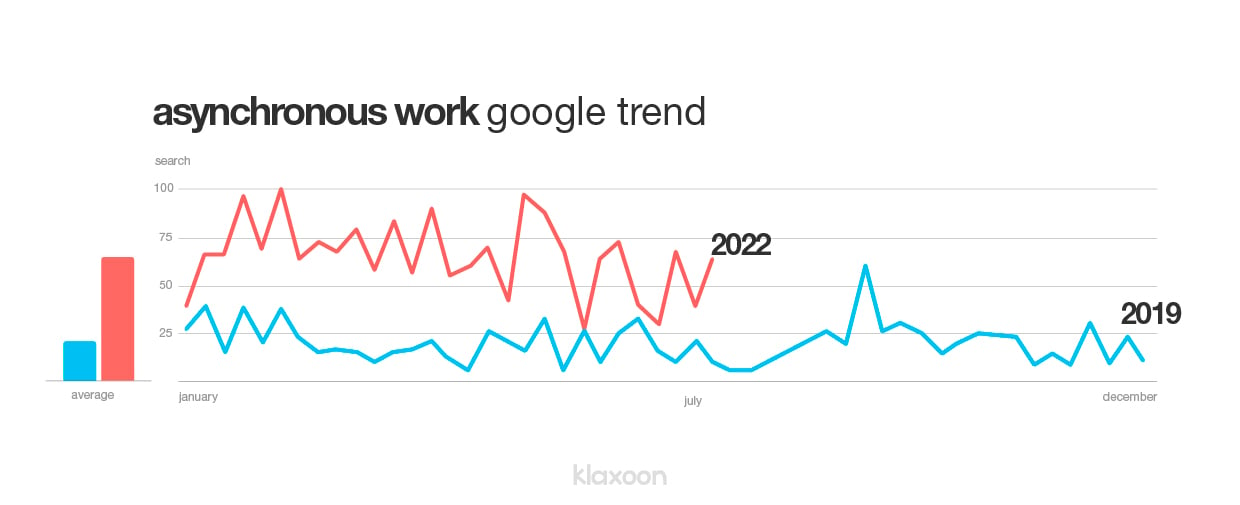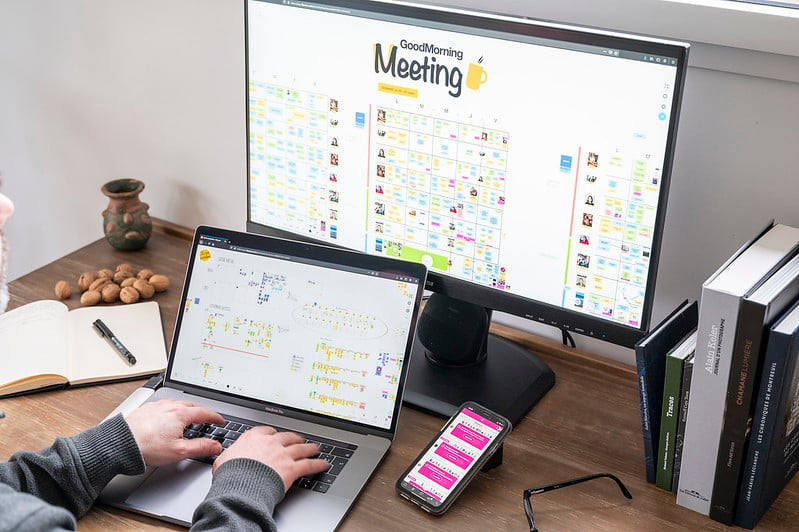What exactly is asynchronous work?
Published on July 30, 2025
What exactly is asynchronous work?
Among the many new words that have entered into daily team routines in recent years, the concept of asynchronous work is becoming increasingly important. It is a real innovation or just a fashionable expression? Here is everything you need to know about asynchronous work.


What exactly is asynchronous work? It can be defined as a different way of working as a team. Group members don’t need to work simultaneously on a project to move forward in the same direction.
Like hybrid work or remote work, the emergence of the concept of asynchronous work is directly linked to the disruption to the world of work caused by the health crisis. Here's the proof at a glance.


There is no better way to tell it. Searches for "asynchronous work" have significantly increased in 2022.
On the graph above, in blue, the search trend for the expression asynchronous work on a well-known search engine in 2019. In red, the same search but in 2022. It’s very clear, the trend has doubled in the space of 3 years.
If asynchronous work is really starting to enter our vocabulary, what is it? A new way of working independently? A paradigm shift in the world of work?
The very existence of synchronous work was unknown until the concept of asynchronous work appeared. A bit like in person, compared to remote work. For decades, most people have worked in an office from 9 AM to 6 PM (select hours as appropriate) every day of the week.
Everyone at the same pace, everyone at the same time. Your meetings, team catch ups, spontaneous conversations and even your coffee breaks. In other words, you work with your colleagues at the same time as them. This is the definition of synchronous work.


A meeting, but in a park. It’s still synchronous work.
With synchronous work, teams have to interrupt project progress when one of the team members is unavailable due to different work schedules or time off.
Meetings are a typical example of a synchronous moment in the working day. Similarly, organizing work according to the “3x8” schedule, namely three teams that take turns every eight hours to maintain continuous production, is an example of asynchronous work.
Unlike synchronous work, asynchronous work is characterized mainly by the time given back to employees:
The main challenge is people’s ability to communicate well and coordinate with each other to keep up with projects and conversations and keep moving forward together.


You’d be amazed at how many things you could do asynchronously. Think about your meetings. How many meetings do you hold to "share information"? If that’s all they're for, not only are you depriving yourself of the true power of meetings, but you’re also wasting your time. Why? Because 9 out of 10 meetings are held when at least one person who was meant to be there is missing.
Information sharing is the number 1 thing that you should do asynchronously.
Think about it seriously. How much information is so important and/or urgent that you need to organize a meeting to communicate it in real time? And how much of it could be transmitted another way? Half? Two-thirds? A shared workspace where you can post your information would be a good way to get started.
If all you want to do is communicate some information, do it asynchronously.
Similarly, you may know that your meetings are much more interactive if you start them… before they officially start.
For example, you probably organize or participate in a regular team meeting, to catch up or resolve complex situations as a team. It is considered a must for collective performance. Listing topics and preparing questions before your meetings is a perfect example of asynchronous collaboration. Everyone's asynchronous work will contribute to the effectiveness of your meeting. Your synchronous work together can be spent on issues to be resolved and decision-making, which are the priority actions to be taken in meetings. And if anyone is missing, those present will know where you are in terms of progress and you can catch up with information in due time.


Asynchronous work is performed by individuals for the benefit of the group.
Finally, asynchronous work is also the norm for all teams working across continents and time zones. Like teams working 3x8 shifts, when one person finishes their working day, another one starts and carries on with the same work. They just need to have the right information to hand.
Asynchronous work is based on three mainstays:
Three mainstays that also apply to the hybrid work model. It's hardly surprising then that these two concepts are gaining ground at the same time with respect to ways of working.
Bastien Le Lann is a Director at Lecko consultancy. A company which specializes in organizational transformation. Alongside their consultancy work, every year they produce a study to get a better understanding of the world of work at that moment. The current 2021 study revealed that, as remote work has become commonplace everywhere, email is still the preferred collaboration tool, alongside video conferencing. However, in-depth analysis highlights that teams are not happy with this, as Bastien explains: "There was an explosion of emails and video conferences during this period of successive lockdowns, and this trend is continuing to grow. We saw the emergence of back-to-back meetings, straight after each other without a break, all day."


Asynchronous work can help put an end to too many meetings.
With their employees no longer physically present, companies massively increased their use of video conferencing tools to keep in touch. But, by imposing synchronous ways of working, this approach proved to be totally inept, something that Steve Glaveski, CEO and co-founder of Collective Campus, an innovation accelerator for companies and start-ups, sees as a missed opportunity in a column for Harvard Business Review.
Arguing that remote work should for the most part be asynchronous, he states that most companies failed to take advantage of the widespread adoption of remote work to improve how they work. "Well-meaning band-aid solutions achieve little if the toxic norms that rob knowledge workers of autonomy and control remain in place. We can help remote workers get on top of their workloads and mitigate work-life balance conflicts by moving away from hyper-responsiveness and real-time communication towards greater asynchronous communication — the type that truly gives people the freedom to decide when and where to work."
While asynchronous work has many advantages, synchronous work should not however be completely abandoned. Quite the opposite. Like hybrid work, which combines the best of both worlds, remote and in-person, companies have an opportunity to create their own work culture, both synchronous and asynchronous, depending on the situation and their needs.
Interviewed by the BBC on this topic, Jen Rhymer, a researcher at the University of Stanford, explains that employees need to ask themselves one key question: "What are the things we really need to do synchronously?"
In the same article, Erica Brescia, COO of Github, a software development and services company, states: "Teams will still want real-time communication to make decisions, do creative brainstorming, and build relationships with their colleagues and customers. And they’ll use async communications to document those decisions, collect input and feedback, track progress and work effectively with team members across time zones."


Asynchronous or synchronous, there’s a way of working to suit every need.
Asynchronous work is gradually becoming a new way of working, as has been the case with remote work. More than a fashionable expression, it’s an opportunity for everyone to decide the pace of each day. A new way to improve engagement at work.
Unlock your teamwork potential